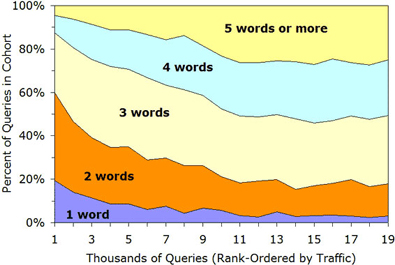Multiple word search queries key for traffic referrals

Jakob Nielsen did an eight-week case-study analysis of traffic to his own site, useit.com, to gauge the impact of frequent, single-word, high-performing search queries versus less-frequent, longer, multiple-word search queries.
In "Traffic Log Paterns," Nielsen discusses why "multiple word queries are the best way to capture the vast range of user interests":
To find useit.com, users employed a total of 110,399 different queries across various search engines. Of these queries, 83% were used only once during the eight-week period.
The top 10 queries accounted for 10% of the total traffic, so each one of these queries is obviously more important than those that brought only one visitor. Taken together, however, the single-use queries accounted for three times as much traffic as the top 10 queries. This statistic shows the folly of focusing search engine optimization solely on a few high-performing queries. Your site must be found when users enter relevant queries -- and the possibilities are typically vast...
As we proceed down the list of query popularity, the queries become longer and longer. The following diagram shows the number of query words for each of the first nineteen groups of a thousand queries. (That is, queries #1-1,000 are first, followed by queries #1,001-2,000, and so on through queries #18,001-19,000.)

Single-word queries were fairly common among the first thousand queries (i.e., those that generated the most traffic), but drop off quite quickly. Conversely, four- and five-word queries are rare among the most popular queries, but are a big proportion of queries starting at about #7,000.
This shows the importance of considering longer queries in your search engine marketing: Multiple word queries are the best way to capture the vast range of user interests.